Donald Rumsfeld
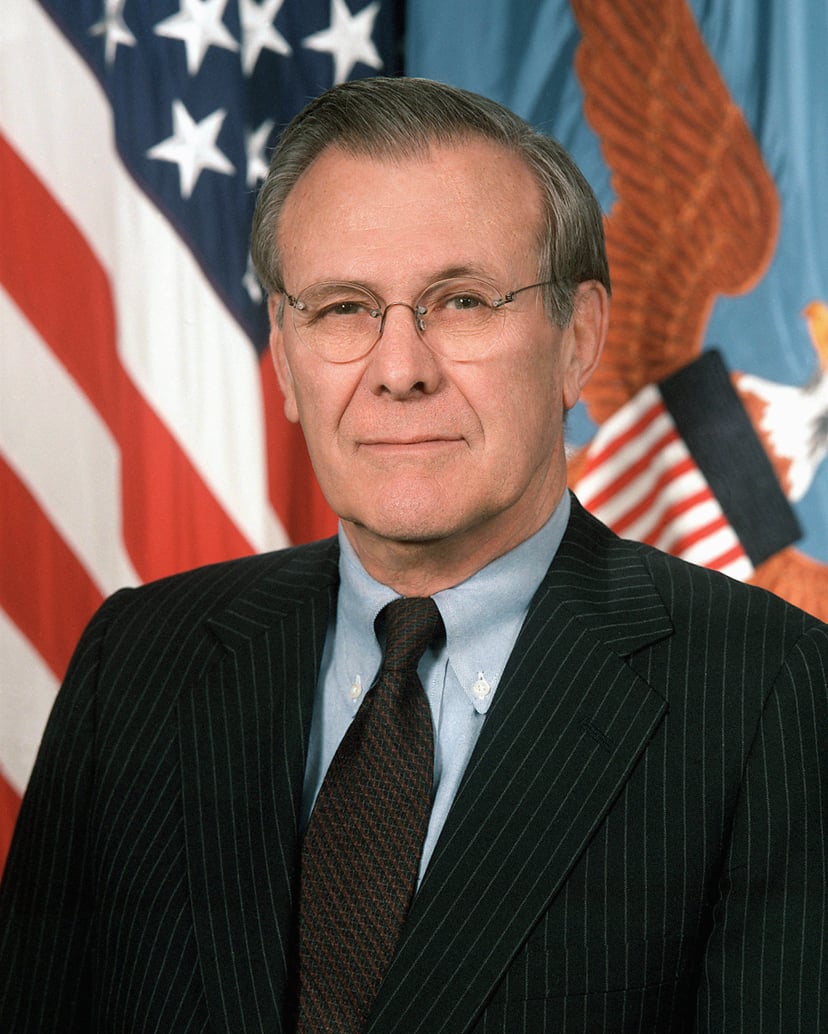
Donald Rumsfeld

| 13th and 21stUnited States Secretary of Defense | |
|---|---|
| January 20, 2001 – December 18, 2006[1] | |
| President | George W. Bush |
| Deputy | |
| William Cohen | |
| Robert Gates | |
| November 20, 1975 – January 20, 1977 | |
| President | Gerald Ford |
| Deputy | Bill Clements |
| James Schlesinger | |
| Harold Brown | |
| 6thWhite House Chief of Staff | |
| September 21, 1974 – November 20, 1975 | |
| President | Gerald Ford |
| Alexander Haig | |
| Dick Cheney | |
| 9thUnited States Ambassador to NATO | |
| February 2, 1973 – September 21, 1974 | |
| President | Richard NixonGerald Ford |
| David Kennedy | |
| David Bruce | |
| Director of theCost of Living Council | |
| October 15, 1971 – February 2, 1973 | |
| Position established | |
| Position abolished | |
| Counselor to the President | |
| December 11, 1970 – October 15, 1971Served withRobert Finch | |
| President | Richard Nixon |
| Bryce HarlowPat Moynihan | |
| Robert Finch | |
| 3rd Director of theOffice of Economic Opportunity | |
| May 27, 1969 – December 11, 1970 | |
| President | Richard Nixon |
| Bertrand Harding | |
| Frank Carlucci | |
| Member of thefromIllinois'sdistrict | |
| January 3, 1963 – March 20, 1969 | |
| Marguerite Church | |
| Phil Crane | |
| Personal details | |
| Born | |
| Political party | Republican |
| Spouse(s) | |
| Children | 3 |
| Education | Princeton University(BA) |
| Signature | |
| Website | |
| Military service | |
| Nickname(s) | "Rummy" |
| Allegiance | United States |
| Branch/service | United States Navy |
| Years of service | 1954–1957 (active)1957–1975 (Reserve)1975–1989 (Ready Reserve) |
| Rank | Captain |

Died In 2021
Donald Henry Rumsfeld (born July 9, 1932 died June 29, 2021)[364] was an American former politician. Rumsfeld served as Secretary of Defense from 1975 to 1977 under Gerald Ford, and again from January 2001 to December 2006 under George W. Bush.[2] He is both the youngest and the second-oldest person to have served as Secretary of Defense. Additionally, Rumsfeld was a three-term U.S. Congressman from Illinois (1963–1969), Director of the Office of Economic Opportunity (1969–1970), Counsellor to the President (1969–1973), the United States Permanent Representative to NATO (1973–1974), and White House Chief of Staff (1974–1975). Between his terms as Secretary of Defense, he served as the CEO and chairman of several companies.
Born in Illinois, Rumsfeld attended Princeton University, graduating in 1954 with a degree in political science. After serving in the Navy for three years, he mounted a campaign for Congress in Illinois's 13th Congressional District, winning in 1962 at the age of 30. While in Congress, he was a leading co-sponsor of the Freedom of Information Act. Rumsfeld reluctantly accepted an appointment by President Richard Nixon to head the Office of Economic Opportunity in 1969; appointed Counsellor by Nixon and entitled to Cabinet-level status, he would also head up the Economic Stabilization Program before being appointed Ambassador to NATO. Called back to Washington in August 1974, Rumsfeld was appointed Chief of Staff by President Ford. Rumsfeld recruited a young one-time staffer of his, Dick Cheney, to succeed him when Ford nominated him to be Secretary of Defense in 1975. When Ford lost the 1976 election, Rumsfeld returned to private business and financial life, and was named president and CEO of the pharmaceutical corporation G. D. Searle & Company. He was later named CEO of General Instrument from 1990 to 1993 and chairman of Gilead Sciences from 1997 to 2001.
Rumsfeld was appointed Secretary of Defense for a second time in January 2001 by President George W. Bush. As Secretary of Defense, Rumsfeld played a central role in the invasion of Afghanistan and invasion of Iraq. Before and during the Iraq War, he claimed that Iraq had an active weapons of mass destruction program; no stockpiles were ever found.[3][4]
A Pentagon Inspector General report found that Rumsfeld's top policy aide "developed, produced, and then disseminated alternative intelligence assessments on the Iraq and al Qaida relationship, which included some conclusions that were inconsistent with the consensus of the Intelligence Community, to senior decision-makers."[5] Rumsfeld's tenure was controversial for its use of torture and the Abu Ghraib torture and prisoner abuse scandal.[6] Rumsfeld gradually lost political support and he resigned in late 2006. In his retirement years, he published an autobiography Known and Unknown: A Memoir as well as Rumsfeld's Rules: Leadership Lessons in Business, Politics, War, and Life.[367]
| 13th and 21stUnited States Secretary of Defense | |
|---|---|
| January 20, 2001 – December 18, 2006[1] | |
| President | George W. Bush |
| Deputy | |
| William Cohen | |
| Robert Gates | |
| November 20, 1975 – January 20, 1977 | |
| President | Gerald Ford |
| Deputy | Bill Clements |
| James Schlesinger | |
| Harold Brown | |
| 6thWhite House Chief of Staff | |
| September 21, 1974 – November 20, 1975 | |
| President | Gerald Ford |
| Alexander Haig | |
| Dick Cheney | |
| 9thUnited States Ambassador to NATO | |
| February 2, 1973 – September 21, 1974 | |
| President | Richard NixonGerald Ford |
| David Kennedy | |
| David Bruce | |
| Director of theCost of Living Council | |
| October 15, 1971 – February 2, 1973 | |
| Position established | |
| Position abolished | |
| Counselor to the President | |
| December 11, 1970 – October 15, 1971Served withRobert Finch | |
| President | Richard Nixon |
| Bryce HarlowPat Moynihan | |
| Robert Finch | |
| 3rd Director of theOffice of Economic Opportunity | |
| May 27, 1969 – December 11, 1970 | |
| President | Richard Nixon |
| Bertrand Harding | |
| Frank Carlucci | |
| Member of thefromIllinois'sdistrict | |
| January 3, 1963 – March 20, 1969 | |
| Marguerite Church | |
| Phil Crane | |
| Personal details | |
| Born | |
| Political party | Republican |
| Spouse(s) | |
| Children | 3 |
| Education | Princeton University(BA) |
| Signature | |
| Website | |
| Military service | |
| Nickname(s) | "Rummy" |
| Allegiance | United States |
| Branch/service | United States Navy |
| Years of service | 1954–1957 (active)1957–1975 (Reserve)1975–1989 (Ready Reserve) |
| Rank | Captain |
Early life
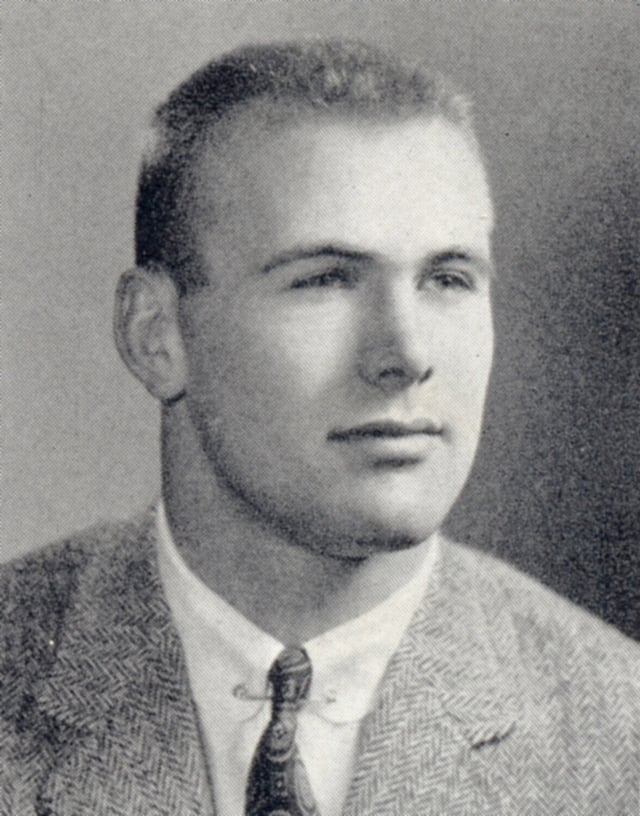
Rumsfeld's 1954 yearbook portrait from Princeton
Donald Henry Rumsfeld was born on July 9, 1932, in Chicago, Illinois, the son of Jeannette Kearsley (née Husted) and George Donald Rumsfeld.[7] His father came from a German-American family that had emigrated in the 1870s from Weyhe in Lower Saxony,[8][9][10] but young Donald was sometimes ribbed about looking like a "tough German".[10] Growing up in Winnetka, Illinois, Rumsfeld became an Eagle Scout in 1949 and is the recipient of both the Distinguished Eagle Scout Award from the Boy Scouts of America[11] and its Silver Buffalo Award in 2006. Living in Winnetka, his family attended a Congregational Church.[12] From 1943–1945, Rumsfeld lived in Coronado, California while his father was stationed on an aircraft carrier in the Pacific in World War II.[13] He was a ranger at Philmont Scout Ranch in 1949.[14]
Rumsfeld attended Baker Demonstration School,[15] and later graduated[16] from New Trier High School. He attended Princeton University on academic and NROTC partial scholarships. He graduated in 1954 with an A.B. in political science. During his time at Princeton, he was an accomplished amateur wrestler, becoming captain of the varsity wrestling team, and captain of the Lightweight Football team playing defensive back. His Princeton University senior thesis was titled "The Steel Seizure Case of 1952 and Its Effects on Presidential Powers".[17] While at Princeton he was friends with another future Secretary of Defense, Frank Carlucci.
Rumsfeld married Joyce P. Pierson on December 27, 1954.
They have three children, six grandchildren, and one great grandchild.
He attended Case Western Reserve University School of Law and Georgetown University Law Center, but did not take a degree from either institution.
Rumsfeld served in the United States Navy from 1954 to 1957, as a naval aviator and flight instructor. His initial training was in the North American SNJ Texan basic trainer after which he transitioned to the T-28 advanced trainer. In 1957, he transferred to the Naval Reserve and continued his naval service in flying and administrative assignments as a drilling reservist. On July 1, 1958, he was assigned to Anti-submarine Squadron 662 at Naval Air Station Anacostia, District of Columbia, as a selective reservist.[18] Rumsfeld was designated aircraft commander of Anti-submarine Squadron 731 on October 1, 1960, at Naval Air Station Grosse Ile, Michigan, where he flew the S2F Tracker.[18] He transferred to the Individual Ready Reserve when he became Secretary of Defense in 1975 and retired with the rank of captain in 1989.[19]
Career in government (1962–1977)
Member of Congress

Rumsfeld during his time in Congress
In 1957, during the Dwight D. Eisenhower administration, Rumsfeld served as Administrative Assistant to David S. Dennison Jr., a Congressman representing the 11th district of Ohio. In 1959, he moved on to become a staff assistant to Congressman Robert P. Griffin of Michigan.[20] Engaging in a two-year stint with an investment banking firm, A. G. Becker & Co., from 1960 to 1962,[21] Rumsfeld would instead set his sights on becoming a member of Congress.
He was elected to the United States House of Representatives for Illinois's 13th congressional district in 1962, at the age of 30, and was re-elected by large majorities in 1964, 1966, and 1968.[22] While in Congress, he served on the Joint Economic Committee, the Committee on Science and Aeronautics, and the Government Operations Committee, as well as on the Subcommittees on Military and Foreign Operations. He was also a co-founder of the Japanese-American Inter-Parliamentary Council[23] in addition to being a leading cosponsor of the Freedom of Information Act.[24]
As a young Congressman, Rumsfeld attended seminars at the University of Chicago, an experience he credits with introducing him to the idea of an all volunteer military, and to the economist Milton Friedman and the Chicago School of Economics.[25] He would later take part in Friedman's PBS series Free to Choose.[26]
During his years in Congress, Rumsfeld supported civil rights legislation such as the 1964 Civil Rights Act.[27]
Nixon Administration

Rumsfeld with his son, Nick, in the Oval Office with President Nixon, 1973
Rumsfeld resigned from Congress in 1969 – his fourth term – to serve President Richard Nixon in his administration, and he would serve in a variety of executive branch positions throughout the Nixon presidency. In 1969, Nixon sought to reform and reorganize the United States Office of Economic Opportunity, an organization created during the Kennedy administration and greatly expanded as a part of Lyndon Johnson's Great Society programs, rather than eliminate it outright. He appointed Rumsfeld Director of the organization with Cabinet rank.[28] Rumsfeld had voted against the creation of OEO when he was in Congress, and initially rejected Nixon's offer, citing his own inherent belief that the OEO did more harm than good, and he felt that he was not the right person for the job.[29] He only accepted after personal pleas from the president.
As Director, Rumsfeld sought to reorganize the Office to serve as "a laboratory for experimental programs".[29] Several beneficial anti-poverty programs were saved by allocating funds to them from other less-successful government programs. During this time, he hired Frank Carlucci and Dick Cheney to serve under him.
He was the subject of one of legendary writer Jack Anderson's columns, alleging that "anti-poverty czar" Rumsfeld had cut programs to aid the poor while spending thousands to redecorate his office. Rumsfeld dictated a four-page response to Anderson, labeling the accusations as falsehoods, and invited Anderson to tour his office. Despite the tour, Anderson did not retract his claims, and would only much later admit that his column was a mistake.[29]
When he left OEO in December 1970, Nixon named Rumsfeld Counselor to the President, a general advisory position; in this role, he retained Cabinet status.[10]{{|75}} He was given an office in the West Wing in 1969 and regularly interacted with the Nixon administration hierarchy. He was named Director of the Economic Stabilization Program in 1970 as well, and later headed up the Cost of Living Council. In March 1971 Nixon was recorded saying about Rumsfeld "at least Rummy is tough enough" and "He's a ruthless little bastard. You can be sure of that."[30][31][32][33][34]
In February 1973, Rumsfeld left Washington to serve as U.S. Ambassador to the North Atlantic Treaty Organization (NATO) in Brussels, Belgium. He served as the United States' Permanent Representative to the North Atlantic Council and the Defense Planning Committee, and the Nuclear Planning Group. In this capacity, he represented the United States in wide-ranging military and diplomatic matters, and was asked to help mediate a conflict on behalf of the United States between Cyprus and Turkey.[29]
Ford Administration
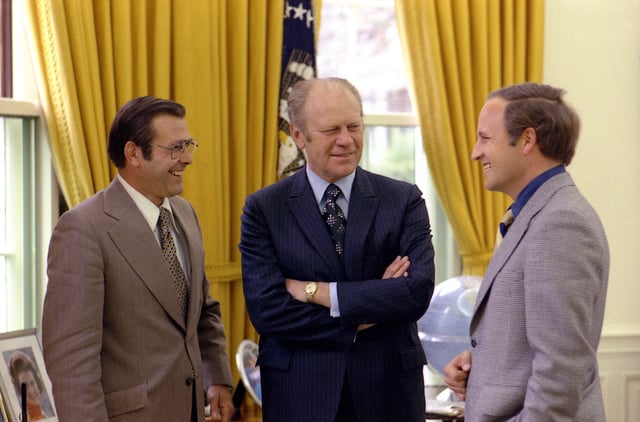
Chief of Staff Rumsfeld (left) and Deputy-Chief of Staff Dick Cheney (right) meet with President Ford, April 1975
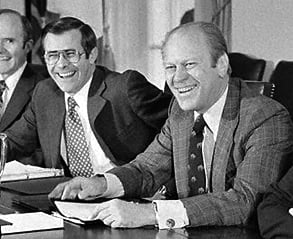
Secretary of Defense Rumsfeld shares a laugh with President Ford in a Cabinet meeting, 1975
In August 1974, after Nixon resigned as president in the aftermath of the Watergate scandal, Rumsfeld was called back to Washington to serve as transition chairman for the new president, Gerald Ford. He had been Ford's confidant since their days in the House, before Ford was House minority leader. As the new president became settled in, Ford appointed Rumsfeld White House Chief of Staff, where he served from 1974 to 1975.
In October 1975, Ford reshuffled his cabinet in the Halloween Massacre. He named Rumsfeld to become the 13th U.S. Secretary of Defense; George H. W. Bush became Director of Central Intelligence. According to Bob Woodward's 2002 book Bush at War, a rivalry developed between the two men and "Bush senior was convinced that Rumsfeld was pushing him out to the CIA to end his political career."[35]
At the Pentagon, Rumsfeld oversaw the transition to an all-volunteer military. He sought to reverse the gradual decline in the defense budget and to build up U.S. strategic and conventional forces, skillfully undermining Secretary of State Henry Kissinger at the SALT talks.[36] He asserted, along with Team B (which he helped to set up),[37] that trends in comparative U.S.-Soviet military strength had not favored the United States for 15 to 20 years and that, if continued, they "would have the effect of injecting a fundamental instability in the world".[19] For this reason, he oversaw the development of cruise missiles, the B-1 bomber, and a major naval shipbuilding program.[36]
In 1977, Rumsfeld was awarded the nation's highest civilian award, the Presidential Medal of Freedom.[1] Kissinger, his bureaucratic adversary, would later pay him a different sort of compliment, pronouncing him "a special Washington phenomenon: the skilled full-time politician-bureaucrat in whom ambition, ability, and substance fuse seamlessly".[38]
Return to the private sector (1977–2000)
Business career
In early 1977 Rumsfeld briefly lectured at Princeton's Woodrow Wilson School and Northwestern's Kellogg School of Management, located in Chicago, Illinois. His sights instead turned to business, and from 1977 to 1985 Rumsfeld served as Chief Executive Officer, President, and then Chairman of G. D. Searle & Company, a worldwide pharmaceutical company based in Skokie, Illinois. During his tenure at Searle, Rumsfeld led the company's financial turnaround, thereby earning awards as the Outstanding Chief Executive Officer in the Pharmaceutical Industry from the Wall Street Transcript (1980) and Financial World (1981). In 1985, Searle was sold to Monsanto Company.
Rumsfeld served as chairman and chief executive officer of General Instrument Corporation from 1990 to 1993. A leader in broadband transmission, distribution, and access control technologies for cable, satellite and terrestrial broadcasting applications, the company pioneered the development of the first all-digital high-definition television (HDTV) technology. After taking the company public and returning it to profitability, Rumsfeld returned to private business in late 1993.
From January 1997 until being sworn in as the 21st Secretary of Defense in January 2001, Rumsfeld served as Chairman of Gilead Sciences, Inc. Gilead Sciences is the developer of Tamiflu (Oseltamivir), which is used in the treatment of bird flu.[39] As a result, Rumsfeld's holdings in the company grew significantly when avian flu became a subject of popular anxiety during his later term as Secretary of Defense. Following standard practice, Rumsfeld recused himself from any decisions involving Gilead, and he directed the Pentagon's General Counsel to issue instructions outlining what he could and could not be involved in if there were an avian flu pandemic and the Pentagon had to respond.[40][41]
Part-time public service

As President Reagan's Special Envoy to the Middle East, Rumsfeld met with Saddam Hussein during a visit to Baghdad in December 1983, during the Iran–Iraq War (see video here).
During his business career, Rumsfeld continued part-time public service in various posts.
In November 1983, Rumsfeld was appointed Special Envoy to the Middle East by President Ronald Reagan, at a turbulent time in modern Middle Eastern history when Iraq was fighting Iran in the Iran–Iraq War. The United States wished for the conflict to end, and Rumsfeld was sent to the Middle East to serve as a mediator on behalf of the President.
When Rumsfeld visited Baghdad on December 20, 1983, he met Saddam Hussein at Saddam's palace and had a 90-minute discussion. They largely agreed on opposing Syria's occupation of Lebanon; preventing Syrian and Iranian expansion; and preventing arms sales to Iran. Rumsfeld suggested that if U.S.-Iraq relations could improve the U.S. might support a new oil pipeline across Jordan, which Iraq had opposed but was now willing to reconsider. Rumsfeld also informed Iraqi Deputy Prime Minister and Foreign Minister Tariq Aziz that "Our efforts to assist were inhibited by certain things that made it difficult for us... citing the use of chemical weapons."[10]
Rumsfeld wrote in his memoir Known and Unknown that his meeting with Hussein "has been the subject of gossip, rumors, and crackpot conspiracy theories for more than a quarter of a century... Supposedly I had been sent to see Saddam by President Reagan either to negotiate a secret oil deal, to help arm Iraq, or to make Iraq an American client state. The truth is that our encounter was more straightforward and less dramatic."[29]
In addition to taking the position of Middle East envoy, Rumsfeld served as a member of the President's General Advisory Committee on Arms Control (1982–1986); President Reagan's Special Envoy on the Law of the Sea Treaty (1982–1983); a senior adviser to President Reagan's Panel on Strategic Systems (1983–1984); a member of the Joint Advisory Commission on U.S./Japan Relations (1983–1984); a member of the National Commission on the Public Service (1987–1990); a member of the National Economic Commission (1988–1989); a member of the Board of Visitors of the National Defense University (1988–1992); a member of the FCC's High Definition Television Advisory Committee (1992–1993); a member of the U.S. Trade Deficit Review Commission (1999–2000); a member of the Council on Foreign Relations; and Chairman of the U.S. Commission to Assess National Security Space Management and Organization (2000). Among his most noteworthy positions was Chairman of the nine-member Commission to Assess the Ballistic Missile Threat to the United States from January to July 1998. In its findings, the commission concluded that Iraq, Iran, and North Korea could develop intercontinental ballistic missile capabilities in five to ten years and that U.S. intelligence would have little warning before such systems were deployed.[42]
During the 1980s, Rumsfeld became a member of the National Academy of Public Administration, and was named a member of the boards of trustees of the Gerald R. Ford Foundation, the Eisenhower Exchange Fellowships, the Hoover Institution at Stanford University and the National Park Foundation. He was also a member of the U.S./Russia Business Forum and Chairman of the Congressional Leadership's National Security Advisory Group. Rumsfeld was a member of the Project for the New American Century, a think-tank dedicated to maintaining U.S. primacy. In addition, he was asked to serve the U.S. State Department as a foreign policy consultant from 1990 to 1993. He also sat on European engineering giant Asea Brown Boveri's board from 1990 to 2001, a company which sold two light-water nuclear reactors to the Korean Peninsula Energy Development Organization for installation in North Korea, as part of the 1994 agreed framework reached under President Bill Clinton. Rumsfeld's office said that he did not "recall it being brought before the board at any time" though Fortune magazine reported that "board members were informed about this project."[43]
Presidential and vice presidential aspirations
During the 1976 Republican National Convention, Rumsfeld received one vote for Vice President of the United States, although he did not seek the office, and the nomination was easily won by Ford's choice, Senator Bob Dole.[44] During the 1980 Republican National Convention he also received one vote for Vice President.[45] Economist Milton Friedman later noted that he, Friedman, regarded Reagan's pick of Bush as "the worst decision not only of his campaign but of his presidency," and that Rumsfeld was instead his preference. "Had he been chosen," Friedman said, "I believe he would have succeeded Reagan as president and the sorry Bush-Clinton period would never have occurred."[46]
Rumsfeld briefly sought the Presidential nomination in 1988, but withdrew from the race before primaries began.[47] During the 1996 election season, he initially formed a presidential exploratory committee, but declined to formally enter the race. He was instead named national chairman for Republican nominee Bob Dole's campaign.[48]
Return to government (2001–2006)
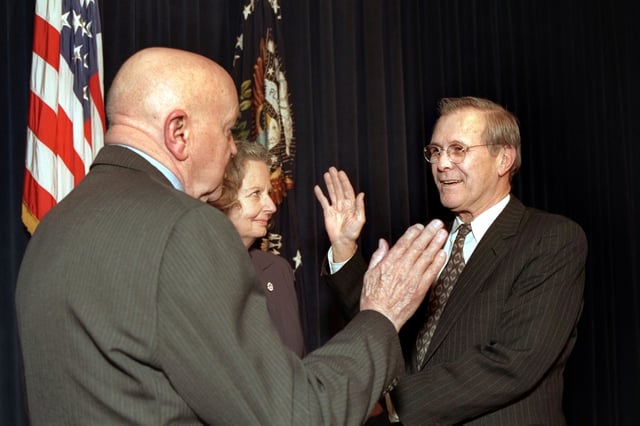
Rumsfeld is administered the oath of office as the 21st Secretary of Defense on January 20, 2001 by Director of Administration and Management David O. Cooke (left), as Joyce Rumsfeld holds the Bible in a ceremony at the Eisenhower Executive Office Building
Rumsfeld was named Secretary of Defense soon after President George W. Bush took office in 2001 despite Rumsfeld's past rivalry with the previous President Bush. Bush's first choice, FedEx founder Fred Smith, was unavailable and Vice President-elect Cheney recommended Rumsfeld for the job.[49]
Rumsfeld's second tenure as Secretary of Defense cemented him as the most powerful Pentagon chief since Robert McNamara and one of the most influential Cabinet members in the Bush administration.[50] His tenure would prove to be a pivotal and rocky one which led the United States military into the 21st century. Following the September 11 attacks, Rumsfeld led the military planning and execution of the U.S. invasion of Afghanistan and the subsequent 2003 invasion of Iraq. He pushed hard to send as small a force as soon as possible to both conflicts, a concept codified as the Rumsfeld Doctrine.
Throughout his time as Defense Secretary, Rumsfeld was noted for his candor and quick wit when giving weekly press conferences or speaking with the press.[51] U.S. News & World Report called him "a straight-talking Midwesterner" who "routinely has the press corps doubled over in fits of laughter".[51] By the same token, his leadership was exposed to much criticism through provocative books covering the Iraq conflict, like Bob Woodward's State of Denial, Thomas E. Ricks' Fiasco, and Seymour Hersh's Chain of Command.
September 11, 2001

"The Pentagon is functioning" was the message Rumsfeld stressed during a press conference in the Pentagon briefing room barely eight hours after terrorists crashed a hijacked commercial jetliner into the Pentagon.
The United States was attacked on September 11, 2001 by al Qaeda terrorists who hijacked commercial airliners and crashed them in coordinated strikes into both towers of the World Trade Center in Lower Manhattan, New York City and the Pentagon in Washington, D.C. The fourth plane crashed into a field in Shanksville, Pennsylvania, and its target was likely a prominent building in Washington, D.C., most probably either the Capitol Building or the White House.[52] Within three hours of the start of the first hijacking and two hours after American Airlines Flight 11 struck the World Trade Center, Rumsfeld raised the defense condition signaling of the United States offensive readiness to DEFCON 3, the highest it had been since the Arab-Israeli war in 1973.[53]
Military decisions in the wake of 9/11
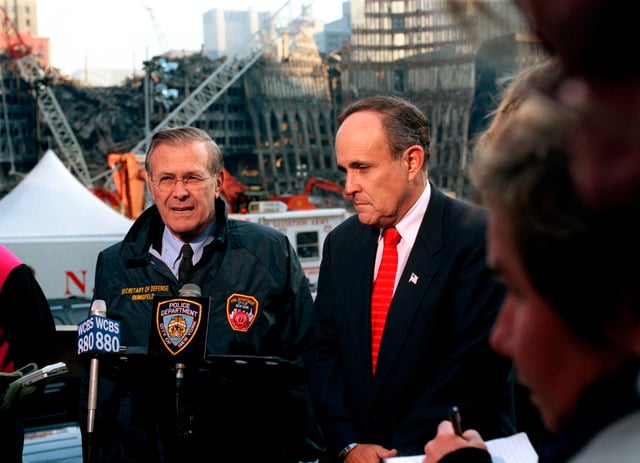
Rumsfeld and New York Mayor Rudy Giuliani speak at the site of the World Trade Center attacks in Lower Manhattan on November 14, 2001

Excerpt from Donald Rumsfeld memo dated Nov 27 2001[56]
On the afternoon of September 11, Rumsfeld issued rapid orders to his aides to look for evidence of possible Iraqi involvement in regard to what had just occurred, according to notes taken by senior policy official Stephen Cambone. "Best info fast. Judge whether good enough hit S.H." – meaning Saddam Hussein – "at same time. Not only UBL" (Osama bin Laden), Cambone's notes quoted Rumsfeld as saying. "Need to move swiftly – Near term target needs – go massive – sweep it all up. Things related and not."[54][55]
Rumsfeld wrote in Known and Unknown, "Much has been written about the Bush administration's focus on Iraq after 9/11. Commentators have suggested that it was strange or obsessive for the President and his advisers to have raised questions about whether Saddam Hussein was somehow behind the attack. I have never understood the controversy. I had no idea if Iraq was or was not involved, but it would have been irresponsible for any administration not to have asked the question."[29]
Iraq War
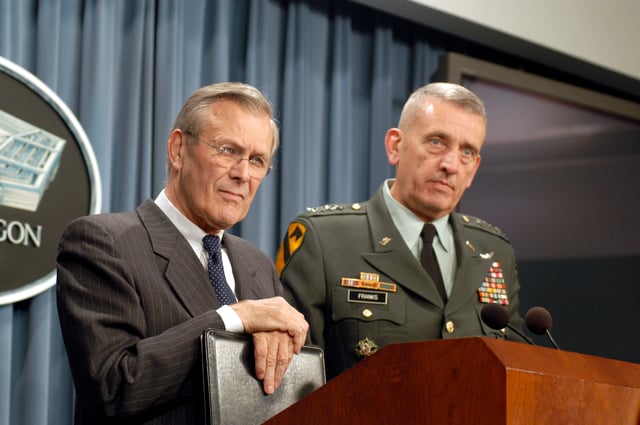
Secretary of Defense Donald H. Rumsfeld (left) and the Commander of U.S. Central Command General Tommy Franks, listen to a question at the close of a Pentagon press conference on March 5, 2003. Rumsfeld and Franks gave reporters an operational update and fielded questions on the possible conflict in Iraq.
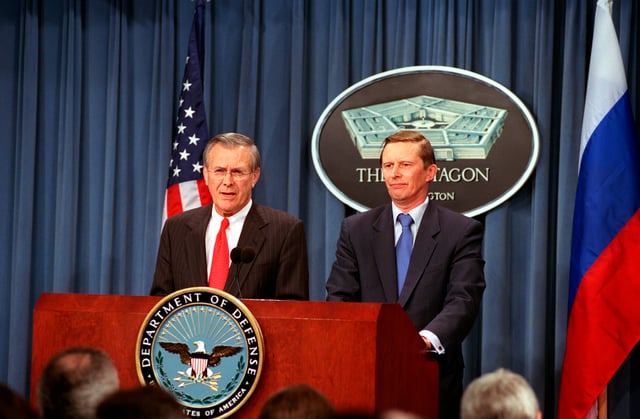
Rumsfeld with Russian Minister of Defense Sergei Ivanov on March 13, 2002. Russia actively supported the American war against terrorism.

Rumsfeld with Uzbek Defense Minister Kadyr Gulyamov. Uzbekistan was a key ally in the War on Terror.
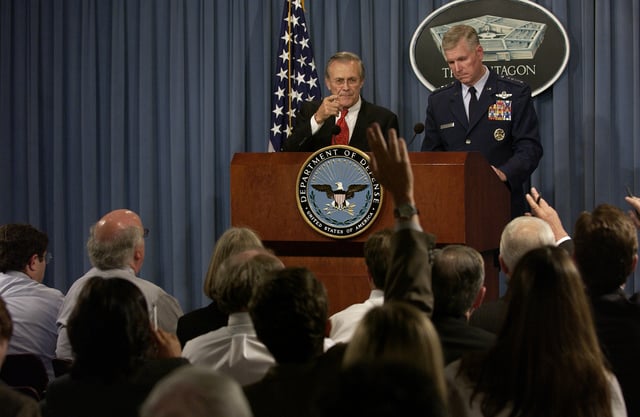
Secretary Rumsfeld responds to a reporter's question during a Pentagon press briefing.
Before and during the Iraq War, Rumsfeld claimed that Iraq had an active weapons of mass destruction program; no stockpiles were ever found.[3][4] Bush administration officials also claimed that there was an operational relationship between Al Qaeda and Saddam Hussein. A Pentagon Inspector General report found that Rumsfeld's top policy aide, Douglas J. Feith, "developed, produced, and then disseminated alternative intelligence assessments on the Iraq and al Qaida relationship, which included some conclusions that were inconsistent with the consensus of the Intelligence Community, to senior decision-makers."[5]
After the war in Afghanistan was launched, Rumsfeld participated in a meeting in regard to the review of the Department of Defense's Contingency Plan in the event of a war with Iraq.
The plan, as it was then conceived, contemplated troop levels of up to 500,000, which Rumsfeld felt was far too many.
Gordon and Trainor wrote:
As [General] Newbold outlined the plan... it was clear that Rumsfeld was growing increasingly irritated.
For Rumsfeld, the plan required too many troops and supplies and took far too long to execute.
It was, Rumsfeld declared, the "product of old thinking and the embodiment of everything that was wrong with the military."[58]
Rumsfeld's plan resulted in a lightning invasion that took Baghdad in well under a month with very few American casualties.
Many government buildings, plus major museums, electrical generation infrastructure, and even oil equipment were looted and vandalized during the transition from the fall of Saddam Hussein's regime to the establishment of the Coalition Provisional Authority. A violent insurrection began shortly after the military operation started. After the German and French governments voiced opposition to invading Iraq, Rumsfeld labeled these countries as part of "Old Europe", implying that countries that supported the war were part of a newer, modern Europe.[59]
As a result, Rumsfeld stirred controversy as to whether the forces that did invade Iraq were enough in size.[58] In a September 2007 interview with The Daily Telegraph, General Mike Jackson, the head of the British army during the invasion, criticized Rumsfeld's plans for the invasion of Iraq as "intellectually bankrupt," adding that Rumsfeld is "one of those most responsible for the current situation in Iraq," and that he felt that "the US approach to combating global terrorism is 'inadequate' and too focused on military might rather than nation building and diplomacy."[57]
In 2006, Rumsfeld responded to a question by Brit Hume of Fox News as to whether he pressed General Tommy Franks to lower his request for 400,000 troops for the war:
Absolutely not.
That's a mythology.
This town [Washington, D.C] is filled with this kind of nonsense.
The people who decide the levels of forces on the ground are not the Secretary of Defense or the President.
We hear recommendations, but the recommendations are made by the combatant commanders and by members of the Joint Chiefs of Staff and there hasn't been a minute in the last six years when we have not had the number of troops that the combatant commanders have requested.[61]
Rumsfeld told Hume that Franks ultimately decided against such a troop level.[[62]](https://www.nytimes.com/glogin?URI=https://www.nytimes.com/2007/10/13/us/13cnd-army.html&OQ=_rQ3D1Q26pagewantedQ3D1Q26hp&OP=1b367f6cQ2FAs5tAFLQ7EgQ20LLQ3EQ27AQ2744Q51A(4A(2A6gA(2Q7EHFQ5DJQ20dQ25chQ3Edo)
There was also controversy between Rumsfeld at the Pentagon and the CIA over who had the authority to fire Hellfire missiles from Predator drones.[63] Even though the drones were not ready for deployment until 2002,[63] Daniel Benjamin and Steven Simon have argued that "these quarrels kept the Predator from being used against al Qaeda... One anonymous individual who was at the center of the action called this episode 'typical' and complained that 'Rumsfeld never missed an opportunity to fail to cooperate. The fact is, the Secretary of Defense is an obstacle. He has helped the terrorists.'[64]
After the Iraq invasion, U.S. troops were criticized for not protecting the historical artifacts and treasures located at the National Museum of Iraq. When asked at the time why U.S. troops did not actively seek to stop the lawlessness, Rumsfeld replied, "Stuff happens... and it's untidy and freedom's untidy, and free people are free to make mistakes and commit crimes and do bad things. They're also free to live their lives and do wonderful things. And that's what's going to happen here."[65] He further commented that, "The images you are seeing on television you are seeing over, and over, and over, and it's the same picture of some person walking out of some building with a vase, and you see it 20 times, and you think, "My goodness, were there that many vases?"[65]
As Secretary of Defense, Rumsfeld was deliberate in crafting the public message from the Department of Defense.
People will "rally" to the word "sacrifice", Rumsfeld noted after a meeting.
"They are looking for leadership.
Sacrifice = Victory."
In May 2004, Rumsfeld considered whether to redefine the war on terrorism as a fight against "worldwide insurgency".
He advised aides "to test what the results could be" if the war on terrorism were renamed.[67] Rumsfeld also ordered specific public Pentagon attacks on and responses to U.S. newspaper columns that reported the negative aspects of the war.
In October 2003, Rumsfeld approved a secret Pentagon "roadmap" on public relations, calling for "boundaries" between information operations abroad and the news media at home.
The Roadmap advances a policy according to which as long as the U.S. government does not intentionally target the American public, it does not matter that psychological operations reach the American public.[68]
The Australia Broadcasting Corporation reported that though Rumsfeld didn't specify a withdrawal date for troops in Iraq, "He says it would be unrealistic to wait for Iraq to be peaceful before removing US led forces from the country, adding that Iraq had never been peaceful and perfect."[69]
Condolence letters
In December 2004, Rumsfeld was heavily criticized for using a signing machine instead of personally signing over 1000 letters of condolence to the families of soldiers killed in action in Iraq and Afghanistan. He promised to personally sign all letters in the future.[70]
Prisoner abuse and torture concerns
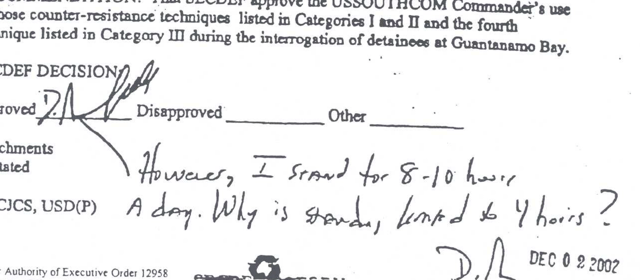
Comment from Rumsfeld: "I stand for 8–10 hours a day.
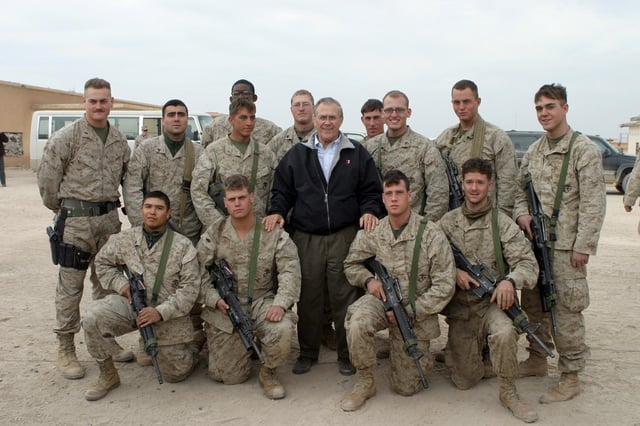
Rumsfeld poses with Marines during one of his trips to Camp Fallujah, Iraq, on Christmas Eve 2004.
The Department of Defense's preliminary concerns for holding, housing, and interrogating captured prisoners on the battlefield were raised during the military build-up prior to the Iraq War.
Because Saddam Hussein's military forces surrendered when faced with military action, many within the DOD, including Rumsfeld and United States Central Command General Tommy Franks, decided it was in the best interest of all to hand these prisoners over to their respective countries. Additionally, it was determined that maintaining a large holding facility was, at the time, unrealistic. Instead, the use of many facilities such as Abu Ghraib would be utilized to house prisoners of interest prior to handing them over, and Rumsfeld defended the Bush administration's decision to detain enemy combatants. Because of this, critics, including members of the U.S. Senate Armed Services Committee, would hold Rumsfeld responsible for the ensuing Abu Ghraib torture and prisoner abuse scandal. Rumsfeld himself said: "These events occurred on my watch as Secretary of Defense. I am accountable for them."[71] He offered his resignation to President Bush in the wake of the scandal, but it was not accepted.[72]
In a memo read by Rumsfeld detailing how Guantanamo interrogators would induce stress in prisoners by forcing them to remain standing in one position for a maximum of four hours, Rumsfeld scrawled a handwritten note on the memo reading: "I stand for 8–10 hours a day.
Why is standing [by prisoners] limited to 4 hours?
D.R.".[73]
Various organizations, such as Human Rights Watch, have called for investigations of Rumsfeld regarding his involvement in managing the Iraq War and his support of the Bush administration's policies of "enhanced interrogation techniques", which are widely regarded as torture.[74][75] Scholars have argued that Rumsfeld "might be held criminally responsible if [he] would be prosecuted by the ICC."[76] In 2005 the ACLU and Human Rights First filed a lawsuit against Rumsfeld and other top government officials, "on behalf of eight men who they say were subjected to torture and abuse by U.S. forces under the command of Defense Secretary Donald Rumsfeld".[77] In 2005, a suit was filed against Rumsfeld by several human rights organizations for allegedly violating U.S. and international law that prohibits "torture and cruel, inhuman, or degrading punishment".[77] Donald Vance and Nathan Ertel filed suit against the U.S. government and Rumsfeld on similar grounds, alleging that they were tortured and their rights of habeas corpus were violated.[78][79][80][81][82][83] In 2007, U.S. District Judge Thomas F. Hogan ruled that Rumsfeld could not "be held personally responsible for actions taken in connection with his government job".[84] The ACLU tried to revive the case in 2011 with no success.[85]
Resignation

Rumsfeld with former British Prime Minister Margaret Thatcher alongside the Chairman of the Joint Chiefs of Staff General Peter Pace, 2006

Rumsfeld shakes President Bush's hand as he announces his resignation, November 8, 2006.
Eight retired generals and admirals called for Rumsfeld to resign in early 2006 in what was called the "Generals Revolt", accusing him of "abysmal" military planning and lack of strategic competence.[86][87][88] Commentator Pat Buchanan reported at the time that Washington Post columnist David Ignatius, who traveled often to Iraq and supported the war, said the generals "mirror the views of 75 percent of the officers in the field, and probably more".[89] Rumsfeld rebuffed these criticisms, stating that "out of thousands and thousands of admirals and generals, if every time two or three people disagreed we changed the secretary of defense of the United States, it would be like a merry-go-round."[90] Bush defended his secretary throughout, and responded by stating that Rumsfeld is "exactly what is needed".[91]
On November 1, 2006, Bush stated he would stand by Rumsfeld as defense secretary for the length of his term as president.[92] Rumsfeld wrote a resignation letter dated November 6, and, per the stamp on the letter, Bush saw it on Election Day, November 7.[93] In the elections, the House and the Senate shifted to Democratic control. After the elections, on November 8, Bush announced Rumsfeld would resign his position as Secretary of Defense. Many Republicans were unhappy with the delay, believing they would have won more votes if voters had known Rumsfeld was resigning.[93]
Retirement and later life (2006–present)

Rumsfeld shares a laugh with his successor, Robert Gates, at a ceremony to unveil his official portrait as Secretary of Defense, June 25, 2010
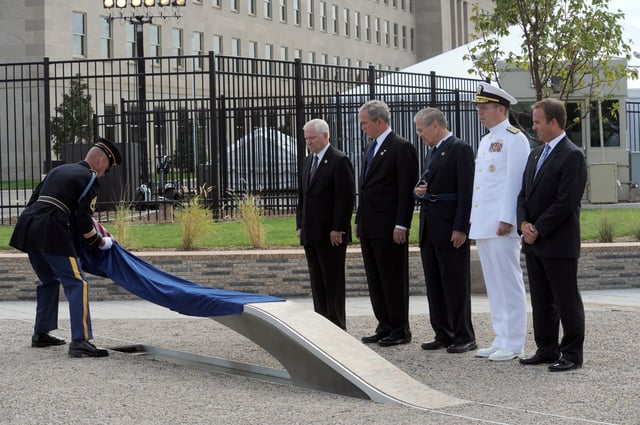
Dedication ceremony of the Pentagon Memorial in 2008
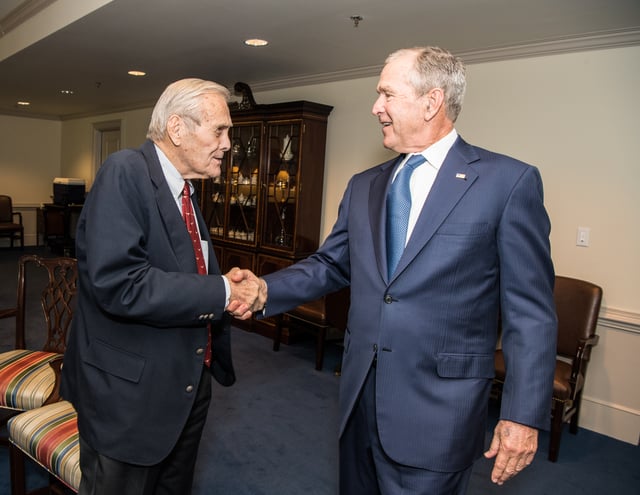
Rumsfeld greeting former President George W. Bush in 2019
In the months after his resignation, Rumsfeld toured the New York publishing houses in preparation for a potential memoir.[97] After receiving what one industry source labeled "big bids", he reached an agreement with the Penguin Group to publish the book under its Sentinel HC imprint.
In 2007, Rumsfeld established The Rumsfeld Foundation, which focuses on encouraging public service in the United States and supporting the growth of free political and free economic systems abroad.
The educational foundation provides fellowships to talented individuals from the private sector who want to serve for some time in government.[98] Rumsfeld personally financed the foundation.[99] As of January 2014, the foundation has sponsored over 90 fellows from Central Asia, provided over $1.2 million in tuition and stipend support for graduate students, awarded over $3 million in microfinance grants, and donated over $2.4 million to charities for veterans affairs.[100]
In conjunction with the publication of Known and Unknown, Rumsfeld established "The Rumsfeld Papers", a website with documents "related to the endnotes" of the book and his service during the George W. Bush administration;[102] during the months that followed the book's publication, the website was expanded to include over 4,000 documents from his archive. As of June 2011, the topics include his Congressional voting record, the Nixon administration, documents and memos of meetings while he was part of the Ford, Reagan, and George W. Bush administrations, private sector documents, and NATO documents, among others.[102]
Rumsfeld was awarded the "Defender of the Constitution Award" at the 2011 Conservative Political Action Conference in Washington, D.C., on February 10, 2011.
After his retirement from government, Rumsfeld criticized former fellow Cabinet member Condoleezza Rice, Secretary of State in his memoir, asserting that she was basically unfit for office. In 2011 she responded, saying that Rumsfeld "doesn't know what he's talking about. The reader may imagine what can be correct about the conflicted matter."[103]
Rumsfeld was the subject of the 2013 Errol Morris documentary The Unknown Known, the title a reference to his response to a question at a February 2002 press conference. In the film Rumsfeld "discusses his career in Washington D.C. from his days as a congressman in the early 1960s to planning the invasion of Iraq in 2003".[105]
In January 2016, in partnership with the literary and creative agency Javelin which handled design and development,[106] Rumsfeld released a mobile app game of solitaire called Churchill Solitaire, emulating a variant of the card game as played by Winston Churchill.[107] Rumsfeld and the Churchill family said that profits from the game would be donated to charity.[108][109]
Electoral history
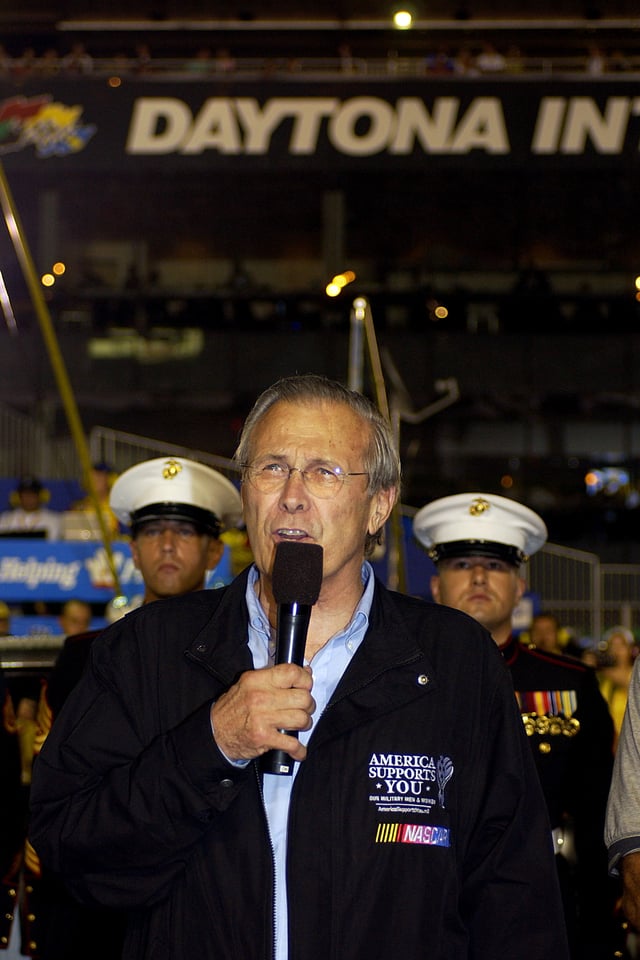
Rumsfeld gives the command at the 2005 Pepsi 400, which he served as the grand marshal[110]
During the four elections during which he ran to represent Illinois's 13th congressional district, Rumsfeld received shares of the popular vote that ranged from 58% (in 1964) to 76% (in 1966). In 1975 and 2001, Rumsfeld was overwhelmingly confirmed by the U.S. Senate after Presidents Gerald Ford and George W. Bush, respectively, appointed him as U.S. Secretary of Defense.
Awards and reputation
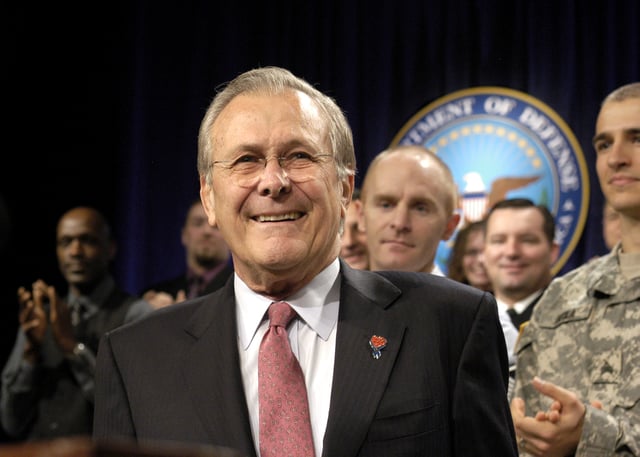
Donald H. Rumsfeld
Rumsfeld has been awarded 11 honorary degrees.[111] Following his years as CEO, president, and later chairman of G. D. Searle & Company, he was recognized as Outstanding CEO in the pharmaceutical industry by the Wall Street Transcript (1980) and Financial World (1981).[112]
Some of his other awards include:
All Navy Wrestling Champion (1956)[111]
The Presidential Medal of Freedom (with Distinction) by President Ford (1977)[113]
George C. Marshall Medal by the Association of the U.S. Army (1984)[114]
Woodrow Wilson Medal by Princeton University (1985)[111]
Dwight D. Eisenhower Medal (1993)[111]
Lone Sailor Award by the U.S. Navy Memorial Foundation (2002)[111]
Statesmanship Award by the United States Association of Former Members of Congress (2003)[111]
Ronald Reagan Freedom Award (2003)[111]
James H. Doolittle Award by the Hudson Institute (2003)[111]
Gerald R. Ford Medal presented by President Ford and the Ford Foundation (2004)[115]
Distinguished Eagle Scout Award by the Boy Scouts of America
Grand Cross of the Order of Merit of the Republic of Poland (2005)[116]
Golden Raspberry Award for Worst Supporting Actor (2004) for his appearance on Fahrenheit 9/11[117]
Union League of Philadelphia Gold Medal for Citizenship (2006)
Claremont Institute Statesmanship Award (2007)
Victory of Freedom Award from the Richard Nixon Foundation (2010)[118]
Order of Anthony Wayne from Valley Forge Military Academy
Special Grand Cordon of the Order of Brilliant Star (2011, Republic of China)[119]
National Flag award from Albania's President Bujar Nishani (2013)[120]
Grand Cordon of the Order of the Rising Sun (2015)
Secretary of State Henry Kissinger described Rumsfeld as "the most ruthless man" he knew.[121]
Affiliation history
Institutional affiliations
Center for Security Policy: Longtime associate; winner of the CSP's 1998 "Keeper of the Flame" award (5)
Hoover Institution: Former member, board of trustees
Project for the New American Century: Signed PNAC's founding statement of principles as well as two policy letters on Iraq
Freedom House: Former board member
RAND Corporation: Former chairman
Committee for the Free World: Former chairman
National Park Foundation: Former member[111]
Eisenhower Exchange Fellowships, Inc.: Former chairman[111]
Bohemian Club: Member
Alfalfa Club: Member
National Academy of Public Administration: Member[111]
Government posts, panels, and commissions
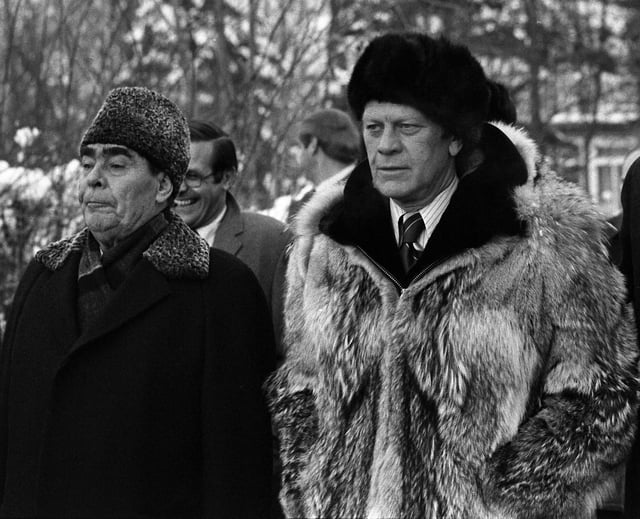
Soviet leader Leonid Brezhnev, President Ford and Rumsfeld in Vladivostok, Soviet Union, November 1974

Rumsfeld and Victoria Nuland at the NATO-Ukraine consultations in Vilnius, Lithuania, on October 24, 2005
Secretary of Defense (2001–06)
U.S. Commission to Assess National Security Space Management and Organization: Chairman (2000)[111]
U.S. Trade Deficit Reviews Commission: Member (1999–2000)[111]
Commission to Assess the Ballistic Missile Threat to the United States: Chairman (1998)[111]
National Commission on Public Service: Member (1987–1990)[111]
National Economic Commission: Member (1988–1989)[111]
President Reagan's General Advisory Committee on Arms Control: Member (1982–1986)[111]
U.S. Joint Advisory Commission on U.S./Japan Relations: Member (1983–1984)[111]
Presidential Envoy to the Middle East, Reagan Administration (1983–1984)[111]
Presidential Envoy on the Law of the Sea Treaty, Reagan Administration (1982–1983)[111]
Secretary of Defense (1975–77)
White House Chief of Staff in Ford administration (1974–75)
U.S. Ambassador to NATO (1973–74)
U.S. Congress: Representative from Illinois (1962–69)
United States Navy: Various posts, including aviator (1954–57); reserves (1957–1975) Retired as a Navy Captain (1989)
Corporate connections and business interests
Eastern Air Lines: Former director – The annual reports of Eastern Air Lines discloses that Donald Rumsfeld was a member of Eastern Air Lines Board of Directors.
Gilead Sciences: Joined Gilead as a director in 1988 Chairman (1997–2001)
General Instrument Corporation: Chairman and CEO (1990–93)
G.D. Searle pharmaceutical company: CEO/Chairman/President (1977–1985)
Gulfstream Aerospace: Former director
Tribune Company: Former director
Metricom, Inc.: Former director
Sears, Roebuck and Co.: Former director
ABB AB: Former director
Kellogg Company: Director 1985–199? while Carlos Gutierrez (x Cuba 1960) was president, CEO and chairman of Kellogg until named Secretary of Commerce under Bush from 2005.
RAND Corporation: Chairman of Board from 1981–1986; 1995–1996
Amylin Pharmaceuticals: Former director
Education
Princeton University: A.B. (1954)
Works
Rumsfeld, Donald (1998).
Strategic imperatives in East Asia. Heritage lectures, no. 605. Washington, D.C.: Heritage Foundation. Speech given March 3, 1998 in Washington, D.C.
Rumsfeld, Donald (2011).
Known and Unknown: A Memoir. Sentinel. ISBN 978-1-59523-067-6.
Rumsfeld, Donald (2013).
Rumsfeld's Rules. Broadside Books. ISBN 9780062272867.
See also
Agathidium rumsfeldi
Early association with liberal activist Allard Lowenstein
There are known knowns
Known and Unknown: A Memoir

